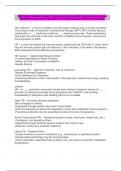NUR 3196 - Module 15 Exam 3 | Questions & Answers (100 %Score) Latest Updated
2024/2025 Comprehensive Questions A+ Graded Answers | With Expert Solutions
HIV treatment - a chronic condition, but with proper medical care, it can be controlled.
The primary mode of treatment is antiretroviral therapy (ART). ART involves taking a
combination of ___ medicines (called an ___ regimen) every day. These medications
help lower the viral load in the body, maintain a healthy immune system, and prevent
the progression to AIDS.
HIV - a virus that attacks the immune system, specifically the CD4 cells (T cells), which
help the immune system fight off infections. If left untreated, it can lead to the disease
AIDS (Acquired Immunodeficiency Syndrome).
HIV causes - -Unprotected Sexual Contact
-Contaminated Blood or Blood Products
-Mother-to-Child Transmission (childbirth)
-Needle Sharing
preventing HIV - -Safe Sex Practices: (use of condoms)
-Needle Exchange Programs
-Early Detection and Treatment
-Preventing Mother-to-Child Transmission: (Prenatal care, antiretroviral drugs, avoiding
breastfeeding)
children
HIV - In ___, prevention measures include early testing of pregnant women for ___,
provision of antiretroviral drugs during pregnancy and childbirth, and avoiding
breastfeeding if alternative safe feeding options are available.
latent TB - -No active disease symptoms.
-Not contagious to others.
-Diagnosed through positive skin tests or blood tests.
-Risk of progressing to active TB, especially in those with weakened immune systems.
-Preventive antibiotics may be prescribed to reduce the risk of progression.
Active Tuberculosis (TB) - -Symptoms present (cough, chest pain, weight loss, etc.).
-Contagious; can spread to others.
-Diagnosed through tests like sputum analysis and chest X-rays.
-Requires months-long antibiotic treatment.
Latent TB - Treatment Plan:
-Usually involves a course of antibiotics (e.g., isoniazid) for a specified duration.
-Directly observed therapy may be recommended.
-Some individuals, especially those at higher risk, may receive preventive medication
(prophylaxis).
, Active Tuberculosis (TB) - Treatment Plan:
-Combination of antibiotics (e.g., isoniazid, rifampin, ethambutol, pyrazinamide).
-Treatment duration typically ranges from 6 to 9 months.
-Directly observed therapy ensures adherence.
-Regular monitoring for side effects and treatment response.
-Isolation precautions to prevent transmission to others.
Tuberculosis Infection - Types:
-Pathogen = mycobacterium ___ (bacillus)
-latent and active forms
Cues:
-none when latent; active disease = fatigue, weight loss, lethargy anorexia, low fever
later in the day, prod. cough with purulent sputum, night sweats, general anxiety,
dyspnea, chest pain, hemoptysis, lymph adenopathy, extrapulmonary symptoms
Diagnosis:
-screening (PPD -Mantoux, IGRA) , sputum sample/stain positive for AFB (acid fast
bacilli),
-Chest Xray - "cavitation", "nodules" "pleural effusions"
Pneumonia Infection - Types:
HAP/VAP, CAP, Bacterial, Viral, Parasitic, and aspiration
Cues:
-often preceded by a viral infection, fever, chills, cough (dry or prod.), labs, malaise,
pleural pain, dyspnea, hemoptysis, systemic infection
Diagnosis:
-H & P, WBC count, C-Reactive Protein elevated, consolidation/infiltrate on chest XRAY
Every client - practice prevention teaching
Treatment: collect sputum sample, hydrate, thin secretions- antibiotics to kill the
pathogen
Hepatits A - route of transmission: Fecal-oral, parenteral, sexual
severity of illness: Mild
age group: Children and young adults
prophylaxis: Hygiene, immune serum globulin, HAV vaccine
Hepatits B - route of transmission: Parenteral, sexual
severity of illness: Severe; maybe prolonged or chronic
age group:Any
prophylaxis: Hygiene, HBV vaccine




